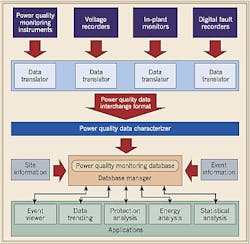Interpreting and Analyzing Power Quality Measurements
Power quality has become a key concern for utility, facility, and consulting engineers because end-use equipment is now more sensitive to disturbances arising both from the utility power supply and within a customer's power distribution system. Also, this equipment is more interconnected in networks and industrial processes, meaning the effects of a problem with any one piece of equipment are much more severe.
This increased awareness of the importance of power quality has generated significant advances in monitoring equipment that can characterize disturbances and power quality variations. (“Categories of Power Quality Variations” below.) Today's monitoring tools can present information as individual events, like disturbance waveforms, trends, or statistical summaries. By comparing events with libraries of typical power quality variation characteristics and correlating them with system events, like capacitor switching, you can determine the causes of these variations.
In the same manner, you can correlate the measured data with verified effects on specific equipment to help characterize the sensitivity of that equipment to power quality variations. This will help you identify what equipment requires power conditioning as well as provide specifications for that protection.
Analyzing measurement data. As we've seen, analyzing power quality measurements has become increasingly more sophisticated. It's not enough to simply look at rms quantities of voltage and current because some disturbances have durations in the millisecond range. In addition, today's end-use equipment is more sensitive to these very short disturbances. Finally, there is more equipment connected to our power systems that, in fact, cause disturbances or power quality problems.
Your data analysis system must be flexible enough to handle data from a variety of monitoring equipment as well as maintain a database you can use for many different applications (Fig. 1 above).
Different types of power quality variations require different types of analysis to characterize system performance. And with a flexible system, you can customize these applications to individual user needs.
Transients. These power quality variations are normally characterized by the actual waveform. However, you can develop summary descriptors for the following:
- Peak magnitude
- Primary frequency
- Time of occurrence
- Rate of rise
RMS variations. These variations are generally characterized by the rms value versus time plot for each event. In other cases, they're characterized by the minimum magnitude of the voltage during the event and the duration of the event.
This method is fine for looking at single sites and single events. But when a whole system is involved, you may want to look at a range of events, such as one month or one year, for multiple sites. This would give you an indication as to what types of rms events are occurring on a given system. The magnitude duration plot in Fig. 2 (click here) shows the minimum voltage, in percent, during the event and the duration of the event (in number of cycles that voltage fell outside of the thresholds).
Another method for displaying this type of data is a three-dimensional bar graph, where the count, magnitude, and duration are shown. Fig. 3 is an example of this type of plot.
Harmonics. Individual snapshots of voltage and current with the associated harmonic spectrums characterize these power quality variations. It's important to note that harmonic distortion levels are always changing, so these characteristics can't be represented with a single snapshot. As a result, you'll need to compile time trends and statistics. Fig. 4 above shows an example time trend plot for one month, and Fig. 5 below shows the statistics of harmonic current level for a much longer period of time.
A data analysis system for power quality measurements should be able to process data from a variety of instruments and support a range of applications for processing the generated data. With continuous power quality monitoring, it's very important to be able to summarize variations with time trends and statistics as well as characterize individual events.
Melhorn is an engineering manager and McGranaghan is vice president of consulting services, both for EPRI-PEAC Corp. in Knoxville, Tenn.
Sidebar: Categories of Power Quality Variations
An IEEE Working Group has developed a consistent set of definitions for coordination of measurements with the intent of providing information that can be shared between different groups that take the measurements and do the evaluations. Power quality variations fall into the two following basic categories:
- Disturbances. These power quality variations are measured by triggering on an abnormality in voltage or current. Transient voltages may be detected when the peak magnitude exceeds a specified threshold. RMS voltage variations, such as sags or interruptions, may be detected when the rms variation exceeds a specified level.
- Steady-state variations. These include normal rms voltage variations and harmonic distortion and must be measured by sampling the voltage and/or current over time. The information is best presented as a trend of the quantity (such as the amount of voltage distortion) over time, and then analyzed using statistical methods.
